Myanmar
Diabetes country report 2011 — 2050
Number of adults (20–79 years) with diabetes in Myanmar (MM)
| 2011 | 2.1 million |
| 2024 | 2.4 million |
| 2050 | 3.3 million |
Myanmar is one of the 37 countries and territories in the Western Pacific Region.
Data source(s) used for the diabetes estimates in adults:
- Myanmar Ministry of Health, Noncommunicable Disease Risk Factor Survey Myanmar 2009.
- WHO STEPS 2014
- Latt TS, Zaw KK, Ko K, et al Diabetes Metab Syndr Obes. 2019;12:291-298. doi:10.2147/DMSO.S156270. PMID:30881072
| Diabetes estimates (20-79 y) | ||||
|---|---|---|---|---|
| People with diabetes, in 1,000s | - | 2,103.7 | 2,365.8 | 3,287.4 |
| Age-standardised prevalence of diabetes, % | - | 7.1 | 6.7 | 7.6 |
| Proportion of people with undiagnosed diabetes, % | - | - | 49.7 | - |
| People with undiagnosed diabetes, in 1,000s | - | - | 1,175.1 | - |
| Impaired Fasting Glucose (IFG) | ||||
|---|---|---|---|---|
| People with IFG, in 1,000s | - | - | 2,590.8 | 3,326.7 |
| Age-standardised prevalence of IFG, % | - | - | 7.2 | 7.7 |
| Impaired Glucose Tolerance (IGT) | ||||
|---|---|---|---|---|
| People with IGT, in 1,000s | - | 2,635.7 | 3,613.3 | 4,440.3 |
| Age-standardised prevalence of IGT, % | - | 8.7 | 10.1 | 10.3 |
| Mortality attributable to diabetes (20-79 y) | ||||
|---|---|---|---|---|
| Deaths attributable to diabetes | - | 58,889.0 | 19,968.3 | - |
| Proportion of diabetes-related deaths in people 20-79 y, % | - | - | 5.5 | - |
| Hyperglycaemia in pregnancy (HIP) (20-49 y) | ||||
|---|---|---|---|---|
| Live births affected by HIP | - | - | - | - |
| Prevalence of gestational diabetes mellitus (GDM), % | - | - | - | - |
| Live births affected by other types of diabetes first detected in pregnancy | - | - | - | - |
| Live births affected by other types of diabetes detected prior to pregnancy | - | - | - | - |
| Diabetes-related health expenditure | ||||
|---|---|---|---|---|
| Total diabetes-related health expenditure, USD million | - | - | 388.1 | 508.0 |
| Total diabetes-related health expenditure, ID million | - | - | 1,912.5 | 2,503.1 |
| Diabetes-related health expenditure per person, USD | - | 16.0 | 164.1 | 154.5 |
| Diabetes-related health expenditure per person, ID | - | - | 808.4 | 761.4 |
| Type 1 diabetes estimates in children and adolescents | ||||
|---|---|---|---|---|
| People with type 1 diabetes (all age groups) | - | - | 1,739.0 | - |
| People with type 1 diabetes (0-19 y) | - | - | 611.9 | - |
| Demographics | ||||
|---|---|---|---|---|
| Total adult population (20-79 y), in 1,000s | - | 31,390.4 | 36,744.7 | 43,019.1 |
| Population of children and adolescents (0-19 y) | - | - | 17,638,863.5 | - |
| Diabetes estimates (20-79 y) | |
|---|---|
| People with diabetes, in 1,000s | - |
| Age-standardised prevalence of diabetes, % | - |
| Proportion of people with undiagnosed diabetes, % | - |
| People with undiagnosed diabetes, in 1,000s | - |
| Impaired Fasting Glucose (IFG) | |
|---|---|
| People with IFG, in 1,000s | - |
| Age-standardised prevalence of IFG, % | - |
| Impaired Glucose Tolerance (IGT) | |
|---|---|
| People with IGT, in 1,000s | - |
| Age-standardised prevalence of IGT, % | - |
| Mortality attributable to diabetes (20-79 y) | |
|---|---|
| Deaths attributable to diabetes | - |
| Proportion of diabetes-related deaths in people 20-79 y, % | - |
| Hyperglycaemia in pregnancy (HIP) (20-49 y) | |
|---|---|
| Live births affected by HIP | - |
| Prevalence of gestational diabetes mellitus (GDM), % | - |
| Live births affected by other types of diabetes first detected in pregnancy | - |
| Live births affected by other types of diabetes detected prior to pregnancy | - |
| Diabetes-related health expenditure | |
|---|---|
| Total diabetes-related health expenditure, USD million | - |
| Total diabetes-related health expenditure, ID million | - |
| Diabetes-related health expenditure per person, USD | - |
| Diabetes-related health expenditure per person, ID | - |
| Type 1 diabetes estimates in children and adolescents | |
|---|---|
| People with type 1 diabetes (all age groups) | - |
| People with type 1 diabetes (0-19 y) | - |
| Demographics | |
|---|---|
| Total adult population (20-79 y), in 1,000s | - |
| Population of children and adolescents (0-19 y) | - |


